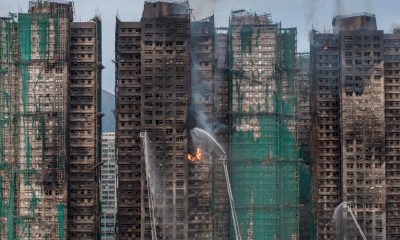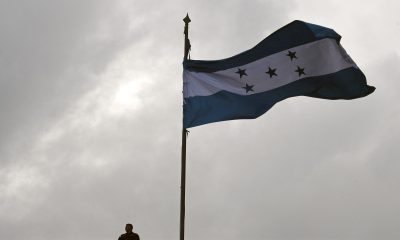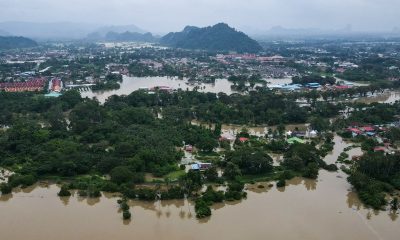International
This will be the choreography of the European election night, from the polls to the results on 9J

When the massive European elections conclude this Sunday night, which call more than 370 million people to the polls in 27 countries, it will be time to know the first data on the composition of the European Parliament for the next five years and what coalitions can be formed.
More than a thousand journalists have been accredited to follow the results of the elections from the headquarters of the European Parliament in Brussels, whose hemicycle will be transformed into a huge press center to follow the data at the continental level on participation, seats and representation of the parties, both at the national and European levels.
All the polls give a roomy victory to the European People’s Party, which will maintain approximately the same number of seats as in the outgoing European Parliament, while the groups that have supported the Von der Leyen majority, social democrats (S&D) and liberals (Renovate Europe), will remain second and third respectively.
Even if they maintain their positions, the Social Democrats will do so with a few fewer seats than in 2019 and the liberals could lose up to 20% of their current seats.
To the right of the EPP, the Conservatives and Reformists (ECR) and the ultra-right Identity and Democracy (ID) will increase their number of MEPs, although with a limited influence due to their fragmentation, while the Greens/European Free Alliance will lose seats until they are sixth force and the Left will remain stable.
The official results will not be known until 11:15 p.m. and no country can publish official results before 11:00 p.m., since Italy does not close the polls until then.
During the afternoon, estimates published by the European Parliament will be known based on polls and polls at the ballot box, which will contain more information as the polling stations in each Member State close.
The first series of country estimates will be known around 6:15 p.m. Two hours later, Parliament will make a first projection of the composition of the European Parliament based on national estimates, pre-election polls or polls at the foot of the ballot box.
The second official screening of the night, at approximately 11:15 p.m., will be the first to contain official results, but not from all countries; some, such as Italy, will just close the polls at that time and others will make a slower count.
The last screening of the night will be published around one in the morning on Monday, June 10, but it is likely that it will take days to know the final result.
The projections published by the European Parliament, however, are based on the groups that existed in the legislature that now concludes; these can be maintained, disappear, win seats or lose them.
On election night, the “cake” of the hemicycle will have an important portion unallocated to any group, corresponding to those national parties that were not in the current European Parliament or that have not reported which groups they will join for the next legislature.
Negotiations to form groups, which bring together MEPs from different countries with similar affinities, can begin on the same day 10 in the morning. To form a group, at least 23 MEPs from a quarter of the Member States must meet; that is, a minimum of seven countries.
International
El Chapo’s son Joaquín Guzmán López pleads guilty to U.S. drug trafficking charges

Joaquín Guzmán López, one of the sons of notorious Mexican drug lord Joaquín “El Chapo” Guzmán, pleaded guilty on Monday to drug trafficking charges in a U.S. court, months after his brother Ovidio reached a similar plea agreement, according to local media reports.
The defendant appeared before a federal court in Chicago early Monday afternoon and changed his previous plea in the case, the Chicago Tribune reported. U.S. authorities accuse him of forming, together with his three brothers, the cartel faction known as “Los Chapitos.”
The group is believed to have continued the operations of El Chapo, who has been serving a life sentence in the United States since 2019.
Guzmán López, 39, was arrested after landing in Texas in a small aircraft alongside cartel co-founder Ismael “El Mayo” Zambada.
International
Venezuela authorizes return flights as U.S. continues deportations amid rising tensions

The arrival of U.S. aircraft carrying undocumented Venezuelan migrants continued regularly despite rising tensions between Washington and Caracas over President Donald Trump’s military deployment in the Caribbean.
Trump maintains that the deployment is part of an anti-narcotics operation, while Venezuelan President Nicolás Maduro insists the true objective is to remove him from power and seize the nation’s oil resources.
Venezuela’s aviation authority has “received a request from the United States government to resume repatriation flights for Venezuelan migrants from that country to Venezuela,” the Ministry of Transportation said in a statement .
“Under the instructions of President Nicolás Maduro, authorization has been granted for these aircraft to enter our airspace,” it added.
Caracas will permit two Eastern Airlines flights to land on Wednesday and Friday.
Migration remains one of the Trump administration’s flagship issues. On Monday, the U.S. president held a meeting with his National Security Council to discuss the situation in Venezuela, a day after confirming he had spoken with Maduro by phone, without offering further details.
According to the Venezuelan government, roughly 75 deportation flights have been carried out this year, returning at least 13,956 Venezuelans from the United States.
International
20,000 rounds stolen from german army after driver leaves cargo unattended

The German army confirmed the theft of a shipment of ammunition that occurred a week ago while it was being transported by a civilian delivery driver, a military spokesperson told AFP, confirming earlier media reports.
According to Der Spiegel and the regional broadcaster MDR, around 20,000 rounds of ammunition were stolen from an unguarded parking lot near Magdeburg, in eastern Germany, while the driver was asleep in a nearby hotel. No information has been released regarding the identity of the suspects, and the military declined to specify the exact type or amount of ammunition taken.
Authorities have also not indicated how the perpetrators knew the cargo would be left unattended.
“The theft was discovered upon delivery at the barracks,” the German army spokesperson said.
A police spokeswoman confirmed to AFP that an investigation has been opened but refused to provide further details “for tactical reasons.”
Sources close to the German military, cited by Der Spiegel, believe it is unlikely the theft was a coincidence. They suspect the thieves waited for the driver to stop for the night before striking.
Der Spiegel also reported that the Defense Ministry normally requires two drivers for this type of transport to ensure the cargo is constantly monitored. However, in this case only one driver was assigned, meaning the civilian transport company failed to comply with the security protocols.
-

 Central America4 days ago
Central America4 days agoTrump Pardons Former Honduran President Hernández and Warns of Aid Cuts Ahead of Election
-

 Central America2 days ago
Central America2 days agoHonduras Extends Voting by One Hour Amid High Turnout, CNE Announces
-

 International1 day ago
International1 day agoHong Kong police arrest 13 over deadly high-rise fire that killed 151
-

 Central America3 days ago
Central America3 days agoHonduras’ China–Taiwan Future Hinges on Sunday’s Presidential Election
-

 International4 days ago
International4 days agoMeta Says Russia Seeks to Ban WhatsApp for Defending Secure Communication
-

 International1 day ago
International1 day agoSri Lanka and Indonesia deploy military as deadly asian floods kill over 1,000
-

 International1 day ago
International1 day agoTrump says asylum decision freeze will remain in place “for a long time”
-

 International1 day ago
International1 day agoChile enters runoff campaign with Kast leading and Jara seeking a last-minute comeback
-

 International3 hours ago
International3 hours agoVenezuela authorizes return flights as U.S. continues deportations amid rising tensions
-

 International3 hours ago
International3 hours agoEl Chapo’s son Joaquín Guzmán López pleads guilty to U.S. drug trafficking charges
-

 International3 hours ago
International3 hours agoTrump convenes National Security Council as U.S.–Venezuela tensions intensify
-

 International3 hours ago
International3 hours ago20,000 rounds stolen from german army after driver leaves cargo unattended






























